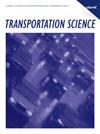Exact and Heuristic Methods for the Split Delivery Vehicle Routing Problem
IF 4.8
2区 工程技术
Q1 OPERATIONS RESEARCH & MANAGEMENT SCIENCE
引用次数: 0
Abstract
This paper describes an exact branch-and-cut (B&C) algorithm for the split delivery vehicle routing problem. The underlying model is based on a previously proposed two-index vehicle flow formulation that models a relaxation of the problem. We dynamically separate two well-known classes of valid inequalities, namely capacity and connectivity cuts, and use an in-out algorithm to improve the convergence of the cutting phase. We generate no-good cuts from feasible integer solutions to the relaxation using a recently proposed single-commodity flow formulation in the literature. The exact methodology is complemented by a very effective adaptive large neighborhood search (ALNS) heuristic that provides high-quality upper bounds to initiate the B&C algorithm. Key ingredients in the design of the heuristic include the use of a tailored construction algorithm, which can exploit the situation in which the ratio of the number of customers to the minimum number of vehicles needed is low, and the use of a route-based formulation to improve the solutions found before, during, and after the ALNS procedure. An earlier version of this work was submitted to the DIMACS (Center for Discrete Mathematics and Theoretical Computer Science) implementation challenge, where it placed third. On sets of well-known benchmark instances for limited and unlimited fleet variants of the problem, we demonstrate that the heuristic provides very competitive solutions, with respective average gaps of 0.19% and 0.18% from best-known values. Furthermore, the exact B&C framework is also highly competitive with state-of-the-art methods, providing solutions with an average optimality gap of 1.82%.History: This paper has been accepted for the Transportation Science Special Section on DIMACS Implementation Challenge: Vehicle Routing Problems.Supplemental Material: The online appendices are available at https://doi.org/10.1287/trsc.2022.0353 .分送车辆路由问题的精确方法和启发式方法
本文介绍了一种针对分送车辆路由问题的精确分支-切割(B&C)算法。其基础模型基于之前提出的双指数车辆流量公式,该公式是对该问题的松弛建模。我们动态地分离了两类众所周知的有效不等式,即容量切分和连通性切分,并使用进出算法来提高切分阶段的收敛性。我们利用最近在文献中提出的单商品流表述,从松弛的可行整数解中生成无优切割。精确方法由一种非常有效的自适应大邻域搜索(ALNS)启发式加以补充,它为启动 B&C 算法提供了高质量的上限。启发式设计的关键要素包括:使用量身定制的构建算法,该算法可以利用客户数量与所需车辆最小数量之比偏低的情况;使用基于路线的公式,以改进在 ALNS 程序之前、期间和之后找到的解决方案。这项工作的早期版本已提交给 DIMACS(离散数学和理论计算机科学中心)实施挑战赛,并获得了第三名的好成绩。在该问题的有限车队和无限车队变体的知名基准实例集上,我们证明启发式提供了极具竞争力的解决方案,与已知最佳值的平均差距分别为 0.19% 和 0.18%。此外,精确的 B&C 框架与最先进的方法相比也具有很强的竞争力,提供的解决方案平均优化差距为 1.82%:本文已被 DIMACS 实施挑战赛交通科学特别单元录用:补充材料:在线附录可从 https://doi.org/10.1287/trsc.2022.0353 获取。
本文章由计算机程序翻译,如有差异,请以英文原文为准。
求助全文
约1分钟内获得全文
求助全文
来源期刊

Transportation Science
工程技术-运筹学与管理科学
CiteScore
8.30
自引率
10.90%
发文量
111
审稿时长
12 months
期刊介绍:
Transportation Science, published quarterly by INFORMS, is the flagship journal of the Transportation Science and Logistics Society of INFORMS. As the foremost scientific journal in the cross-disciplinary operational research field of transportation analysis, Transportation Science publishes high-quality original contributions and surveys on phenomena associated with all modes of transportation, present and prospective, including mainly all levels of planning, design, economic, operational, and social aspects. Transportation Science focuses primarily on fundamental theories, coupled with observational and experimental studies of transportation and logistics phenomena and processes, mathematical models, advanced methodologies and novel applications in transportation and logistics systems analysis, planning and design. The journal covers a broad range of topics that include vehicular and human traffic flow theories, models and their application to traffic operations and management, strategic, tactical, and operational planning of transportation and logistics systems; performance analysis methods and system design and optimization; theories and analysis methods for network and spatial activity interaction, equilibrium and dynamics; economics of transportation system supply and evaluation; methodologies for analysis of transportation user behavior and the demand for transportation and logistics services.
Transportation Science is international in scope, with editors from nations around the globe. The editorial board reflects the diverse interdisciplinary interests of the transportation science and logistics community, with members that hold primary affiliations in engineering (civil, industrial, and aeronautical), physics, economics, applied mathematics, and business.
 求助内容:
求助内容: 应助结果提醒方式:
应助结果提醒方式:


